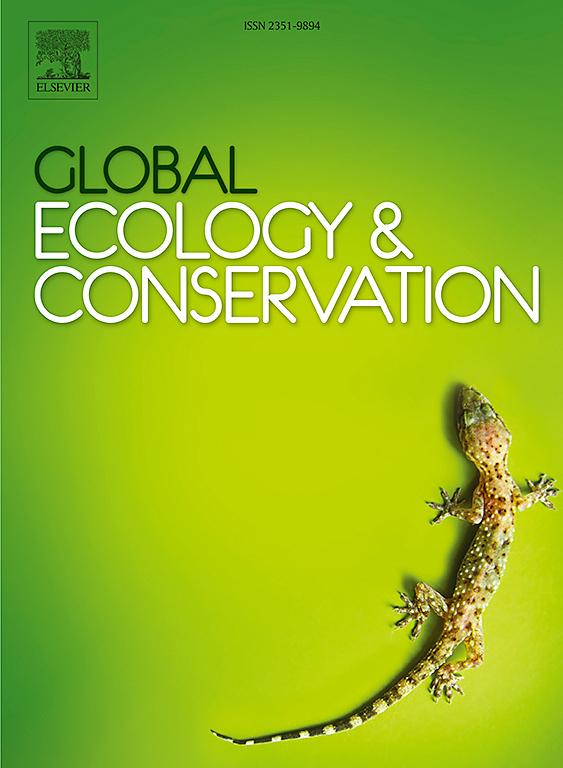Environmental thresholds triggering changes in above and belowground biomass carbon in China
IF 3.5
2区 环境科学与生态学
Q1 BIODIVERSITY CONSERVATION
引用次数: 0
Abstract
Quantifying the dynamics of above and belowground biomass carbon (AGBC and BGBC) is essential for optimizing carbon sink management. However, the environmental thresholds that govern these dynamics under climate change remain poorly understood in China. In this study, we identified key thresholds by examining the relationships between AGBC (4485 observations) and BGBC (3442 observations) with mean annual temperature (MAT), aridity index (AI), and soil pH. Thresholds for AGBC were 15.24°C (MAT), 1.17 (AI), and 6.87 (pH), while those for BGBC were 14.37°C, 0.65, and 7.99, respectively. Additionally, we explored these thresholds in different ecosystems (forests, grasslands, shrublands, and wetlands). By spatially mapping these thresholds, we delineated environmentally sensitive areas—regions currently below (or above) the thresholds that are projected to exceed (or fall below) them under future climate scenarios. Using machine learning algorithms, we modeled AGBC and BGBC distributions for the years 2010 and 2100 (SSP5–8.5 scenario) and identified regions with the most significant expected changes. Overlaying threshold-sensitive areas with projected vegetation carbon changes revealed that AGBC is likely to increase in the southeastern Tibetan Plateau, while BGBC is projected to increase in the northern Shandong Province (Likelihood > 66 %). These shifts are primarily driven by regional warming and humidification that exceed identified MAT and AI thresholds. By integrating threshold identification with spatial and temporal analyses, this study enhances our understanding of vegetation carbon responses to climate change.
触发中国地上地下生物量碳变化的环境阈值
量化地上、地下生物量碳动态对优化碳汇管理至关重要。然而,在气候变化的背景下,控制这些动态的环境阈值在中国仍然知之甚少。本研究通过分析AGBC(4485次)和BGBC(3442次)与年平均温度(MAT)、干旱指数(AI)和土壤pH之间的关系,确定了关键阈值。AGBC的阈值分别为15.24°C (MAT)、1.17°C (AI)和6.87°C (pH), BGBC的阈值分别为14.37°C、0.65°C和7.99°C。此外,我们还在不同的生态系统(森林、草原、灌丛和湿地)中探索了这些阈值。通过对这些阈值进行空间映射,我们划定了环境敏感区域——目前低于(或高于)阈值的区域,在未来气候情景下预计将超过(或低于)阈值。利用机器学习算法,我们模拟了2010年和2100年(SSP5-8.5情景)的AGBC和BGBC分布,并确定了预期变化最显著的区域。植被碳变化预估的阈值敏感区叠加显示,青藏高原东南部的AGBC可能增加,而山东北部的BGBC可能增加(Likelihood >;66 %)。这些变化主要是由超过确定的MAT和AI阈值的区域变暖和变湿所驱动的。本研究将阈值识别与时空分析相结合,增强了对植被碳对气候变化响应的认识。
本文章由计算机程序翻译,如有差异,请以英文原文为准。
求助全文
约1分钟内获得全文
求助全文
来源期刊

Global Ecology and Conservation
Agricultural and Biological Sciences-Ecology, Evolution, Behavior and Systematics
CiteScore
8.10
自引率
5.00%
发文量
346
审稿时长
83 days
期刊介绍:
Global Ecology and Conservation is a peer-reviewed, open-access journal covering all sub-disciplines of ecological and conservation science: from theory to practice, from molecules to ecosystems, from regional to global. The fields covered include: organismal, population, community, and ecosystem ecology; physiological, evolutionary, and behavioral ecology; and conservation science.
 求助内容:
求助内容: 应助结果提醒方式:
应助结果提醒方式:


